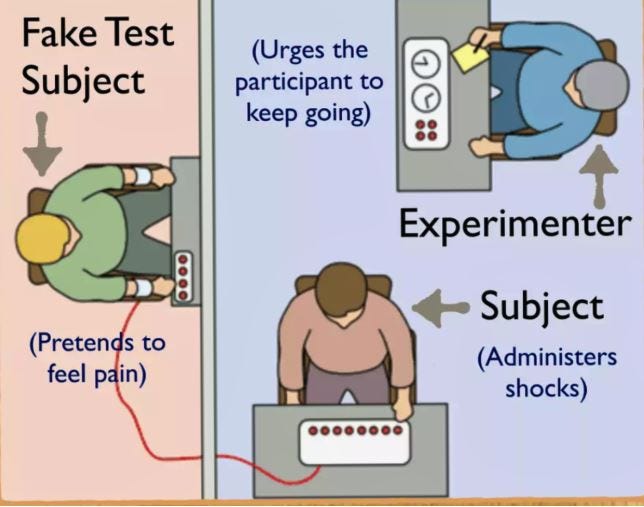The Milgram Experiment and our potential to obey cruelty
How humans can switch from good to evil
Whenever we hear about genocides or other atrocities carried out by sinister authoritarian states throughout history, we often find ourselves wondering how things could have spiraled so far out of control. If only a small percentage of humans are psychopaths or just downright evil, why did no one step in to stop these acts of cruelty as they unfolded in our societies? Surely, if 99.9% of humans are mostly good, then statistically, we shouldn't see cruel state leaders acting with impunity toward their subordinates, right?
There are many answers to these seemingly naive questions, but one reason I want to address in this article is our inherent tendency to obey authority—sometimes with little to no hesitation at all.
The Milgram Experiment is one of the most famous psychological studies of obedience to authority, conducted by psychologist Stanley Milgram in the early 1960s at Yale University. It aimed to understand how far individuals would go in obeying an authority figure, even if it involved inflicting harm on another person.
The Experiment Setup
Participants were told they were part of a study on learning and memory. They were assigned the role of a "teacher" (unbeknownst to them, this role was pre-determined). Another person, the "learner," was secretly an actor who was part of the study.
The teacher was instructed to administer electric shocks to the learner each time the learner made a mistake in a word-pairing task.
The shocks increased in intensity with each mistake, ranging from 15 volts (labeled as "Slight Shock") to 450 volts ("Danger: Severe Shock").
The learner, seated in another room, did not actually receive shocks but acted as though they were, screaming in pain, begging to stop, or eventually going silent.
If the teacher hesitated, the experimenter (an authority figure in a lab coat) would give verbal prods such as:
"Please continue."
"The experiment requires that you continue."
"It is absolutely essential that you continue."
"You have no other choice; you must go on."
Results and Conclusions
Milgram found that a staggering 65% of participants (teachers) continued to administer shocks up to the maximum 450 volts, despite the apparent distress or silence of the learner! Most participants showed visible signs of stress and discomfort though, but they still obeyed the authority figure.
What the Milgram Experiment tells us about human behavior is the fact that people are surprisingly willing to obey authority figures, even when it conflicts with their personal morals or causes harm to others, and that social contexts and pressure from authority figures can also strongly influence our behavior. In this context participants often shifted the responsibility for their actions to the authority figure, rationalizing their behavior as "just following orders". Lastly, the situation and perceived legitimacy of the authority (e.g., a scientist in a lab coat) were also key factors in driving obedience.
The Milgram Experiment teaches us an important lesson: ordinary, good people may find themselves, much to their surprise, committing atrocities when placed in situations where they feel compelled to obey authority figures. It is crucial to know yourself and develop an unshakable moral compass to avoid the disastrous pitfalls that can lead both you and the world down the wrong path!





We're the COVID lockdowns a planetary Milgram experiment?